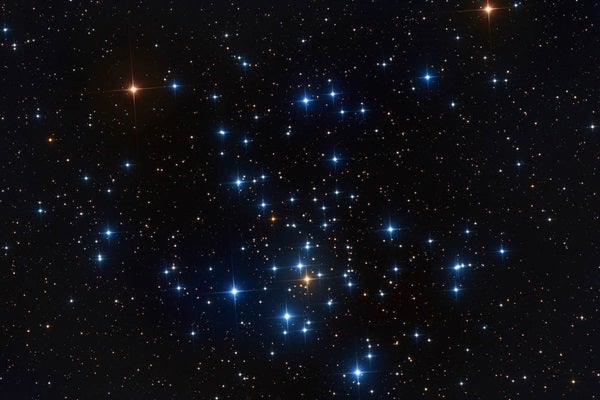NGC 2516 is an open star cluster in the southern constellation Carina the Keel. Amateur astronomers refer to it as the Southern Beehive because of its resemblance to M44 (see #94), the open cluster in Cancer the Crab. It lies some 1,300 light-years away and has an apparent diameter of 30′, similar to that of the Full Moon. Various teams of astronomers have estimated its age at between 110 million and 135 million years.
French astronomer Nicolas Louis de Lacaille discovered it in 1751, using a ½-inch refractor. That may not seem like a large scope, but such an instrument gathers 3.3 times as much light as a fully dark-adapted human eye. And that increase in light-gathering power was just enough to allow Lacaille to find objects either too faint for the eye or just dense enough that the eye can’t quite resolve them into stars.
To find this spectacular cluster, look 3.3° west-southwest of magnitude 1.9 Avior (Epsilon [ε] Carinae), the southwestern star in the asterism known as the False Cross. Because NGC 2516 glows at magnitude 3.8, you’ll have no trouble spotting it with your naked eyes — it’s one of the sky’s 20 brightest open clusters.
If you point a 6-inch telescope at this cluster, you might be able to count 75 stars, but it won’t be easy. That’s because the stars fall into two brightness ranges. The upper range starts with SAO 250055 — a magnitude 5.8 red giant, making it the cluster’s brightest star — and includes those members brighter than magnitude 8. To see the lower range of stars, crank the power beyond 250x to spread the bright stars out. If you don’t, their light will hide the many faint stars within the cluster. When using high power on NGC 2516, you’ll come across several double stars (and even one triple star) whose brightness straddles the line between the two classes.
Make sure to explore Astronomy’s full list of 101 cosmic objects you must see. New entries will be added each week throughout 2022.
To get the latest astronomical news and observing content delivered directly to your door, subscribe to Astronomy magazine today!










